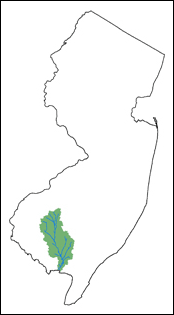|
Maurice River Recollections Project
Osprey Nest Anecdotes
Burcham
This was the second nest we erected, and it was one of two put up on one weekend. The other has since been removed. The one we removed was too close to a tree line later suspected of having nesting horned owls. Over time, we learned that the most suitable nests have very clear sight distances. A 360º view and a distance of 200' or more from a dense tree line fosters the greatest interest in nesting pairs. This nest is named for the people who own the property closest to the nest: the Burcham Sisters. They are twin sisters (one is now deceased), Janice and Jeanette Burcham. They are living legends on our river. Their home has been in the same family since it was built in 1860 and is the winner of a Century Farm award. The bricks of the home were manufactured on site from the clays of the Maurice River. It is NJ's last remaining diked farm. Originally, we used 24- 6”x6” poles for nesting platforms. The height, we felt, increased the sight distance of the birds. In order to erect a nest we had to use scaffolding. We used to use an old pallet hung off the edge of the pole, making the pole less balanced and unusually heavy. The combination of imbalanced, long, and weighty made the pole very difficult to manage. Added to these difficulties, we put the nest in a very muddy bottom and 4' of water. The inevitable happened on the day we put it up: the structure got away from us and took out a small pram we were using for the pump, and hit two spectators. Fortunately, no one was hurt and the nest proved successful. Since then we have changed to 16' poles and use a well-balanced structure. Ten feet above the marsh plain is sufficient for success and makes maintenance and banding much more efficient. Also, we try to find marsh areas where we might have the best footing. In our river basin, this is not an easy task. At times, we have laid a couple of sheets of plywood so we don't sink in the muck above our knees.
View of Burcham Farm from Burcham Nest
Scaffold is used to affix a new platform on an existing pole
Closest River Reach: Yawp Shore http://www.cumauriceriver.org/reaches/pg/narratives.cfm?sku=19 |
Osprey Colony Project
Introduction Welcome to Citizens United's River Recollections Project. These stories are but a few of my memories associated to osprey nesting structures along the Maurice River and its tributaries. It is part of a larger project including an interactive map of the of river reach lore, live campfire recollection events, documentaries, presentations and archives held by the organization. I believe the greatest connection that people have to a river is the sharing of their bond to it through the telling of stories. These stories are accurate accounts from my perspective the truth, as I know it. The stories are designed to give you insight into some life history of the osprey but are primarily designed to give you a flavor for being an osprey volunteer. Over 150 volunteers have been involved in the construction of the osprey platforms. Sincerely,
|


 If you enjoy these stories or have a love of history, you may find visiting our interactive River Reach Map, which allows you to explore cultural aspects of the Maurice River's tidal reaches, simply click on buoys to begin your voyage.
If you enjoy these stories or have a love of history, you may find visiting our interactive River Reach Map, which allows you to explore cultural aspects of the Maurice River's tidal reaches, simply click on buoys to begin your voyage.